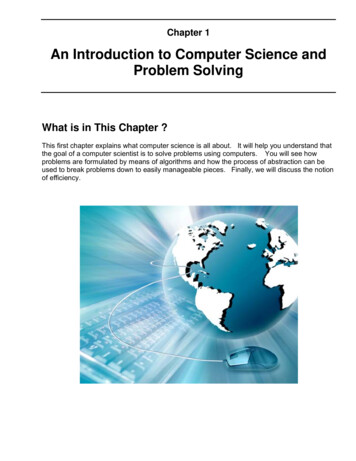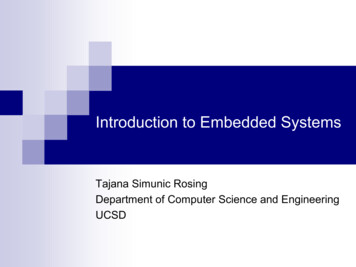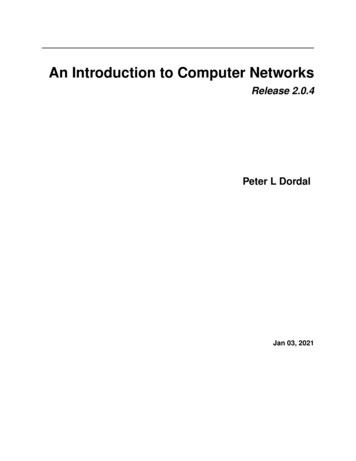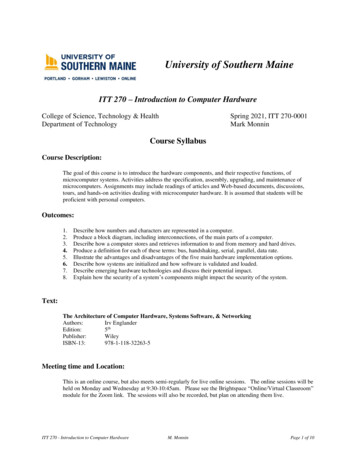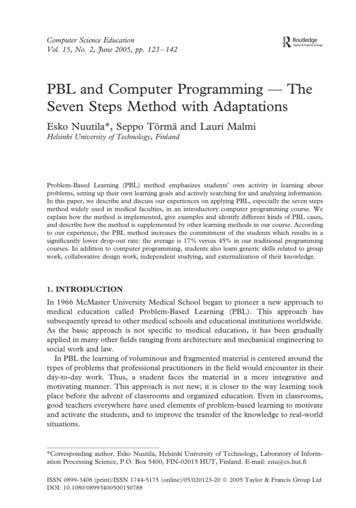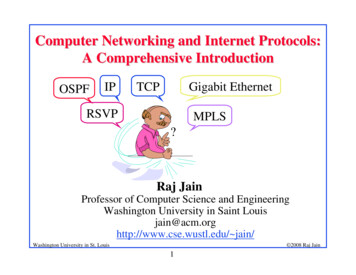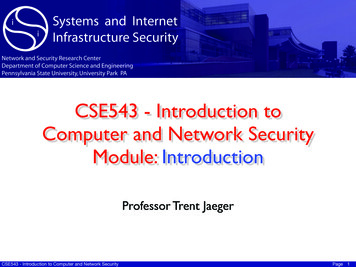
Transcription
II3YSTEMS AND )NTERNET)NFRASTRUCTURE 3ECURITY.ETWORK AND 3ECURITY 2ESEARCH #ENTER EPARTMENT OF #OMPUTER 3CIENCE AND %NGINEERING0ENNSYLVANIA 3TATE 5NIVERSITY 5NIVERSITY 0ARK 0!CSE543 - Introduction toComputer and Network SecurityModule: IntroductionProfessor Trent JaegerCSE543 - Introduction to Computer and Network SecurityPage 1
Some bedtime stories CSE543 - Introduction to Computer and Network SecurityPage 2
Some bedtime stories CSE543 - Introduction to Computer and Network SecurityPage 2
Some bedtime stories CSE543 - Introduction to Computer and Network SecurityPage 2
to nightmares Age85Heart 8075Pain70Obesity656055504540353025Mental Health Acne2015Reproductive Health 0 0 % Items 1 AgeHormones 85 nfection65Male Enhancement6055Pain504540Pain35Pain30Mental Health25AcneMental Health Mental Health20ObesityMale Pattern BaldnessMale Pattern BaldnessReproductive HealthAcne 15 AcneMale EnhancementHeartObesityInfection % Items(a) GlavMed110 0% Items12% Items(b) SpamItFigure 5: Items purchased separated into product category and customer age. The left half of each graph show orders from women,and the right half shows orders from men. Customers restricted to those who self-report age and sex.CSE543 - Introduction to Computer and Network SecurityPage 3
This course We are going to explore why these events are notisolated, infrequent, or even unexpected. Why are we doing so poorly in computing systems atprotecting our users and data from inadvertent orintentional harm?CSE543 - Introduction to Computer and Network SecurityPage 4
This course We are going to explore why these events are notisolated, infrequent, or even unexpected. Why are we doing so poorly in computing systems atprotecting our users and data from inadvertent orintentional harm?The answer: stay tuned!CSE543 - Introduction to Computer and Network SecurityPage 4
This course . This course is a systems coursecovering general topics incomputer and network security,including:‣ network security, software security,OS security, web security,cryptography, authentication, securityprotocol design and analysis, keymanagement, intrusion detection,security policy, language-basedsecurity, cloud computing security,and other emerging topics (as timepermits)CSE543 - Introduction to Computer and Network SecurityPage 5
You need to understand . How a Computer Works Modern Operating Systems IP Networks Discrete Mathematics Basics of systems theory and implementation‣ E.g., File systems, distributed systems, networking, operatingsystems, .CSE543 - Introduction to Computer and Network SecurityPage 6
Goals‣ My goal: to provide you with the tools to understand andevaluate research in computer security.‣ Basic technologies‣ Engineering/research trade-offs‣ How to read/understand security research papers This is going to be a hard course. The key to success issustained effort. Failure to keep up with readings andproject will likely result in poor grades, and ultimately littleunderstanding of the course material. Pay-off: security competence is a rare, valuable skillCSE543 - Introduction to Computer and Network SecurityPage 7
Course Materials Website - I am maintaining the course website at‣ http://www.cse.psu.edu/ tjaeger/cse543-s15/ Course assignments, slides, and other artifacts will bemade available on the course website. Course textbook‣ Introduction to Computer Security Michael Goodrich and Roberto TamassiaCSE543 - Introduction to Computer and Network SecurityPage 8
Course Calendar The course calendar as all therelevant readings, assignments andtest dates The calendar page containselectronic links to online papersassigned for course readings. Please check the website frequentlyfor announcements and changes tothe schedule. Students areresponsible for any change on theschedule.CSE543 - Introduction to Computer and Network SecurityPage 9
Grading The course will be graded on exams, projects, paperreviews and class participation in the followingproportions:35% Projects20% Mid-term Exam35% Final Exam (comprehensive)10% Paper Reviews & ParticipationCSE543 - Introduction to Computer and Network SecurityPage 10
Exams Midterm and Final‣ Same Format‣ Short Answer Questions What is X?‣ Conceptual Questions Why is Y?‣ Constructions How is Z? Time can be an issue‣ Answer the questions you know Final is worth far more than midtermCSE543 - Introduction to Computer and Network SecurityPage 11
Readings There are a large amount of readings in this coursecovering various topics. These assignments areintended to:‣ Support the lectures in the course (provide clarity)‣ Augment the lectures and provide a broader exposure tosecurity topics. Students are required to do the reading! About 10-20% of questions on the tests will be off thereading on topics that were not covered in class. Youbetter do the reading or you are going to be in deeptrouble when it comes to grades.CSE543 - Introduction to Computer and Network SecurityPage 12
Paper reviews Goal: Record key ideas and methods for later We will review one paper per weekCSE543 - Introduction to Computer and Network SecurityPage 13
Projects Goal: Learn security Goal: Learn research skills Projects Security Research Projects Small teams Examine a research question Will have either implementation or experimentation Likely topics Passwords, Crypto protocols, Software security, PrivacyCSE543 - Introduction to Computer and Network SecurityPage 14
Ethics Statement This course considers topics involving personal and public privacy andsecurity. As part of this investigation we will cover technologieswhose abuse may infringe on the rights of others. As an instructor, Irely on the ethical use of these technologies. Unethical use mayinclude circumvention of existing security or privacy measurementsfor any purpose, or the dissemination, promotion, or exploitation ofvulnerabilities of these services. Exceptions to these guidelines mayoccur in the process of reporting vulnerabilities through public andauthoritative channels. Any activity outside the letter or spirit ofthese guidelines will be reported to the proper authorities and mayresult in dismissal from the class and or institution. When in doubt, please contact the instructor for advice. Do notundertake any action which could be perceived as technology misuseanywhere and/or under any circumstances unless you have receivedexplicit permission from Professor Jaeger.CSE543 - Introduction to Computer and Network SecurityPage 15
What is security? Garfinkel and Spafford (1991)‣ “A computer is secure if you can depend on it andits software to behave as expected.” Harrison, Ruzzo, Ullman (1978)‣ “Prevent access by unauthorized users” Not really satisfactory – does not truly capturethat security speaks to the behavior of others‣ Expected by whom?‣ Under what circumstances?CSE543 - Introduction to Computer and Network SecurityPage 16
Risk At-risk valued resources that can be misused‣ Monetary‣ Data (loss or integrity)‣ Time‣ Confidence‣ Trust What does being misused mean?‣ Confidentiality‣ Integrity‣ Availability‣ Privacy (personal) Q: What is at stake in your life?CSE543 - Introduction to Computer and Network SecurityPage 17
Adversary An adversary is any entity trying tocircumvent the security infrastructure‣ The curious and otherwise generally clueless (e.g., script-kiddies)‣ Casual attackers seeking to understand systems‣ Venal people with an ax to grind‣ Malicious groups of largely sophisticated users (e.g, chaos clubs)‣ Competitors (industrial espionage)‣ Governments (seeking to monitor activities)CSE543 - Introduction to Computer and Network SecurityPage 18
Are users adversaries? Have you ever tried to circumvent the security of asystem you were authorized to access? Have you ever violated a security policy (knowingly orthrough carelessness)?CSE543 - Introduction to Computer and Network SecurityPage 19
Are users adversaries? Have you ever tried to circumvent the security of asystem you were authorized to access? Have you ever violated a security policy (knowingly orthrough carelessness)?This is known as the insider adversary!CSE543 - Introduction to Computer and Network SecurityPage 19
Threats A threat is a specific means by which an adversary can put asystem at risk‣ An ability/goal of an adversary (e.g., eavesdrop, fraud, access denial)‣ Independent of what can be compromised A threat model is a collection of threats that deemedimportant for a particular environment‣ A collection of adversary(ies) abilities‣ E.g., a powerful adversary can read and modify all communications andgenerate messages on a communication channel Q: What were risks/threats in the introductory examples?‣ Slammer‣ Yale/Princeton‣ EstoniaCSE543 - Introduction to Computer and Network SecurityPage 20
Vulnerabilities (attack vectors) A vulnerability is a flaw that is accessible to anadversary who can exploit that flaw E.g., buffer-overflow, WEP key leakage What is the source of a vulnerability?‣ Bad software (or hardware)‣ Bad design, requirements‣ Bad policy/configuration‣ System Misuse‣ Unintended purpose or environment E.g., student IDs for liquor storeCSE543 - Introduction to Computer and Network SecurityPage 21
Attacks An attack occurs when an adversary attempts toexploit a vulnerability Kinds of attacks‣ Passive (e.g., eavesdropping)‣ Active (e.g., password guessing)‣ Denial of Service (DOS) Distributed DOS – using many endpoints A compromise occurs when an attack is successful‣ Typically associated with taking over/altering resourcesCSE543 - Introduction to Computer and Network SecurityPage 22
Principals Principals are expected system subjects‣ Computers, agents, people, enterprises, ‣ Depending on context referred to as: servers, clients, users,entities, hosts, routers, - and some may be adversarial‣ Security is defined with respect to these subjects Implication: every principal may have unique view A trusted third party‣ Trusted by all principals for some set of actions‣ Often used as introducer or arbiterCSE543 - Introduction to Computer and Network SecurityPage 23
Trust Trust refers to the degree to which a principal isexpected to behave‣ What the principal not expected to do? E.g., not expose password‣ What the principal is expected to do (obligations)? E.g., obtain permission, refresh A trust model describes, for a particular environment,who is trusted to do what? Note: you make trust decisions every day‣ Q: What are they?‣ Q: Whom do you trust?CSE543 - Introduction to Computer and Network SecurityPage 24
Security Model A security model is the combination of a trust and threatmodels that address the set of perceived risks‣ The “security requirements” used to develop some cogent andcomprehensive design‣ Every design must have security model LAN network or global information system Java applet or operating system This class is going to talk a lot about security models‣ What are the security concerns (risks)?‣ Who are our adversaries?‣ What are the threats?‣ Who do we trust and to do what? Systems must be explicit to be secure.CSE543 - Introduction to Computer and Network SecurityPage 25
A Security Model Example Assume we have a University website that hostscourses through the web (e.g., Angel)‣ Syllabus, other course information‣ Assignments submissions‣ Online grading In class: elements of the security model‣ Principals (Trusted)‣ Adversaries‣ Risks‣ ThreatsCSE543 - Introduction to Computer and Network SecurityPage 26
Michael Goodrich and Roberto Tamassia 8. CSE543 - Introduction to Computer and Network Security Page Course Calendar The course calendar as all the relevant readings, assignments and test dates The calendar page contains electronic links to online papers assigned for course readings. Please check the website frequently for announcements and changes to the schedule. Students are .


